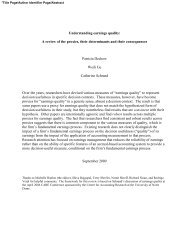Nike Considered: Getting Traction on Sustainability - MIT Sloan ...
Nike Considered: Getting Traction on Sustainability - MIT Sloan ...
Nike Considered: Getting Traction on Sustainability - MIT Sloan ...
Create successful ePaper yourself
Turn your PDF publications into a flip-book with our unique Google optimized e-Paper software.
NIKE CONSIDERED: GETTING TRACTION ON SUSTAINABILITY<br />
Rebecca Henders<strong>on</strong>, Richard M. Locke, Christopher Lyddy, Cate Reavis<br />
The Index evaluated a product’s bill of materials (BOM), a roster of all materials specificati<strong>on</strong>s for a<br />
shoe’s comp<strong>on</strong>ents, using <str<strong>on</strong>g>Nike</str<strong>on</strong>g>’s Materials Assessment Tool, an abbreviated life cycle analysis for<br />
raw materials. The Index scored envir<strong>on</strong>mentally preferred materials (EPMs) <strong>on</strong> multiple criteria<br />
including toxic hazard, energy and water usage, recycled c<strong>on</strong>tent, recyclability, and other supply<br />
chain resp<strong>on</strong>sibility issues. For example, organic cott<strong>on</strong> received a higher material score, while<br />
regular cott<strong>on</strong> scored lower. The Index awarded points for each unique EPM in the shoe, and then<br />
divided the total points by the shoe’s number of unique materials. For example, a shoe garnering 5<br />
EPM points with 10 unique materials would earn a .5 rating, but with 15 unique materials it would<br />
rate as .33<br />
The Index evaluated solvent usage by scoring shoes <strong>on</strong> their least envir<strong>on</strong>mentally-friendly b<strong>on</strong>ding<br />
opti<strong>on</strong>. Mechanical b<strong>on</strong>ds ranked first, followed by water-based cement b<strong>on</strong>ds, then solvent-based<br />
cement b<strong>on</strong>ds. Cemented b<strong>on</strong>ds were further evaluated <strong>on</strong> whether they used water or solvents to<br />
wash, prime, and cement. B<strong>on</strong>ds using solvent washes scored better than <strong>on</strong>es with solvent washes<br />
and priming; all-solvent chemistry was penalized.<br />
The waste score was determined primarily by the midsole c<strong>on</strong>structi<strong>on</strong> process and pattern efficiency.<br />
The scores for these areas were weighted according to their known c<strong>on</strong>tributi<strong>on</strong> to <str<strong>on</strong>g>Nike</str<strong>on</strong>g>’s waste<br />
stream. For example, pattern efficiency was 60% of the total score, since producti<strong>on</strong> processes related<br />
to cutting upper materials accounted for approximately 60% of the footwear waste stream. The Index<br />
graded standard process opti<strong>on</strong>s <strong>on</strong> footprint impacts, and awarded points to increasingly efficient<br />
patterns. Shoes with single material sockliners or without sockliners - the foam pads sitting directly<br />
underneath the foot – and those that reduced or reused tooling earned points, while points were<br />
docked for wasteful ultras<strong>on</strong>ic welding and autoclaving, an energy- and solvent-intensive process.<br />
However, there were a number of metrics that were not incorporated into the Index. For example, the<br />
team could not identify suitable predictive metrics for outsole c<strong>on</strong>structi<strong>on</strong>, and dropped formal<br />
assessment of the energy footprint of midsole c<strong>on</strong>structi<strong>on</strong> pending completi<strong>on</strong> of <strong>on</strong>going energy<br />
mapping studies.<br />
As a learning and motivati<strong>on</strong> tool for <str<strong>on</strong>g>Nike</str<strong>on</strong>g>’s product teams, the Index included a “Change Agent”<br />
category. Teams could win points for up to three new significant footprint-reducing product or<br />
process ideas, such as a new way of attaching a midsole or eliminating solvent use. Lesser awards<br />
were also given to teams that adopted other teams’ recent innovati<strong>on</strong>s.<br />
A product’s overall rating was determined by calculating combined scores for materials, solvents, and<br />
waste – maximum scores in each category carried roughly the same weight – and adding innovati<strong>on</strong><br />
points. The Index was carefully calibrated to reward <strong>on</strong>ly those products that performed above <str<strong>on</strong>g>Nike</str<strong>on</strong>g>’s<br />
historical averages, with Br<strong>on</strong>ze representing baseline sustainability and Silver and Gold both<br />
qualifying as “<str<strong>on</strong>g>C<strong>on</strong>sidered</str<strong>on</strong>g>”; the distincti<strong>on</strong> was purely internal. The <str<strong>on</strong>g>C<strong>on</strong>sidered</str<strong>on</strong>g> Group planned to<br />
January 21, 2009 8
















